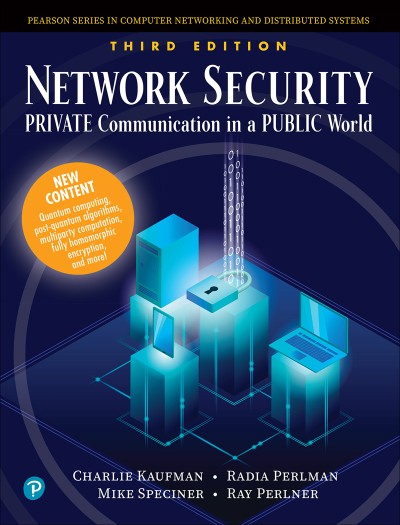Most Commented
NetWork Security: Private Communication in a Public World - Charlie Kaufman




Description material

epub | 15.22 MB | English | Isbn:9780136643524 | Author: Charlie Kaufman, Radia Perlman, Mike Speciner, Ray Perlner | Year: 2023
About ebook: Network Security: Private Communication in a Public World
The classic guide to cryptography and network security – now fully updated!
"Alice and Bob are back!"
Widely regarded as the most comprehensive yet comprehensible guide to network security and cryptography, the previous editions of Network Security received critical acclaim for lucid and witty explanations of the inner workings of cryptography and network security protocols. In this edition, the authors have significantly updated and revised the previous content, and added new topics that have become important.
This book explains sophisticated concepts in a friendly and intuitive manner. For protocol standards, it explains the various constraints and committee decisions that led to the current designs. For cryptographic algorithms, it explains the intuition behind the designs, as well as the types of attacks the algorithms are designed to avoid. It explains implementation techniques that can cause vulnerabilities even if the cryptography itself is sound. Homework problems deepen your understanding of concepts and technologies, and an updated glossary demystifies the field's jargon. Network Security, Third Edition will appeal to a wide range of professionals, from those who design and evaluate security systems to system administrators and programmers who want a better understanding of this important field. It can also be used as a textbook at the graduate or advanced undergraduate level.
Coverage includes
Network security protocol and cryptography basics
Design considerations and techniques for secret key and hash algorithms (AES, DES, SHA-1, SHA-2, SHA-3)
First-generation public key algorithms (RSA, Diffie-Hellman, ECC)
How quantum computers work, and why they threaten the first-generation public key algorithms
Quantum-safe public key algorithms: how they are constructed, and optimizations to make them practical
Multi-factor authentication of people
Real-time communication (SSL/TLS, SSH, IPsec)
New applications (electronic money, blockchains)
New cryptographic techniques (homomorphic encryption, secure multiparty computation)
"Alice and Bob are back!"
Widely regarded as the most comprehensive yet comprehensible guide to network security and cryptography, the previous editions of Network Security received critical acclaim for lucid and witty explanations of the inner workings of cryptography and network security protocols. In this edition, the authors have significantly updated and revised the previous content, and added new topics that have become important.
This book explains sophisticated concepts in a friendly and intuitive manner. For protocol standards, it explains the various constraints and committee decisions that led to the current designs. For cryptographic algorithms, it explains the intuition behind the designs, as well as the types of attacks the algorithms are designed to avoid. It explains implementation techniques that can cause vulnerabilities even if the cryptography itself is sound. Homework problems deepen your understanding of concepts and technologies, and an updated glossary demystifies the field's jargon. Network Security, Third Edition will appeal to a wide range of professionals, from those who design and evaluate security systems to system administrators and programmers who want a better understanding of this important field. It can also be used as a textbook at the graduate or advanced undergraduate level.
Coverage includes
Category:Computers, Networking & Telecommunications, Security - Computer Networks
Warning! You are not allowed to view this text.
Warning! You are not allowed to view this text.
Join to our telegram Group
Information
Users of Guests are not allowed to comment this publication.
Users of Guests are not allowed to comment this publication.
Choose Site Language
Recommended news
Commented



![eM Client Pro 9.2.1735 Multilingual [Updated]](https://pikky.net/medium/wXgc.png)






![Movavi Video Editor 24.0.2.0 Multilingual [ Updated]](https://pikky.net/medium/qhrc.png)

